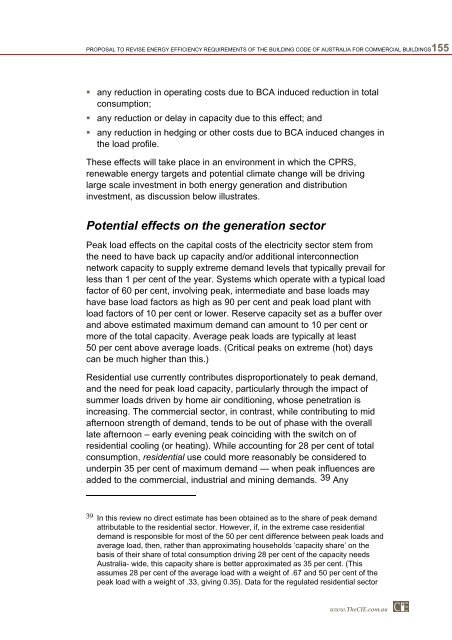PDF | 2 MB - Australian Building Codes Board
PDF | 2 MB - Australian Building Codes Board
PDF | 2 MB - Australian Building Codes Board
Create successful ePaper yourself
Turn your PDF publications into a flip-book with our unique Google optimized e-Paper software.
PROPOSAL TO REVISE ENERGY EFFICIENCY REQUIREMENTS OF THE BUILDING CODE OF AUSTRALIA FOR COMMERCIAL BUILDINGS 155<br />
• any reduction in operating costs due to BCA induced reduction in total<br />
consumption;<br />
• any reduction or delay in capacity due to this effect; and<br />
• any reduction in hedging or other costs due to BCA induced changes in<br />
the load profile.<br />
These effects will take place in an environment in which the CPRS,<br />
renewable energy targets and potential climate change will be driving<br />
large scale investment in both energy generation and distribution<br />
investment, as discussion below illustrates.<br />
Potential effects on the generation sector<br />
Peak load effects on the capital costs of the electricity sector stem from<br />
the need to have back up capacity and/or additional interconnection<br />
network capacity to supply extreme demand levels that typically prevail for<br />
less than 1 per cent of the year. Systems which operate with a typical load<br />
factor of 60 per cent, involving peak, intermediate and base loads may<br />
have base load factors as high as 90 per cent and peak load plant with<br />
load factors of 10 per cent or lower. Reserve capacity set as a buffer over<br />
and above estimated maximum demand can amount to 10 per cent or<br />
more of the total capacity. Average peak loads are typically at least<br />
50 per cent above average loads. (Critical peaks on extreme (hot) days<br />
can be much higher than this.)<br />
Residential use currently contributes disproportionately to peak demand,<br />
and the need for peak load capacity, particularly through the impact of<br />
summer loads driven by home air conditioning, whose penetration is<br />
increasing. The commercial sector, in contrast, while contributing to mid<br />
afternoon strength of demand, tends to be out of phase with the overall<br />
late afternoon – early evening peak coinciding with the switch on of<br />
residential cooling (or heating). While accounting for 28 per cent of total<br />
consumption, residential use could more reasonably be considered to<br />
underpin 35 per cent of maximum demand — when peak influences are<br />
added to the commercial, industrial and mining demands. 39 Any<br />
39 In this review no direct estimate has been obtained as to the share of peak demand<br />
attributable to the residential sector. However, if, in the extreme case residential<br />
demand is responsible for most of the 50 per cent difference between peak loads and<br />
average load, then, rather than approximating households ‘capacity share’ on the<br />
basis of their share of total consumption driving 28 per cent of the capacity needs<br />
Australia- wide, this capacity share is better approximated as 35 per cent. (This<br />
assumes 28 per cent of the average load with a weight of .67 and 50 per cent of the<br />
peak load with a weight of .33, giving 0.35). Data for the regulated residential sector<br />
www.TheCIE.com.au
















